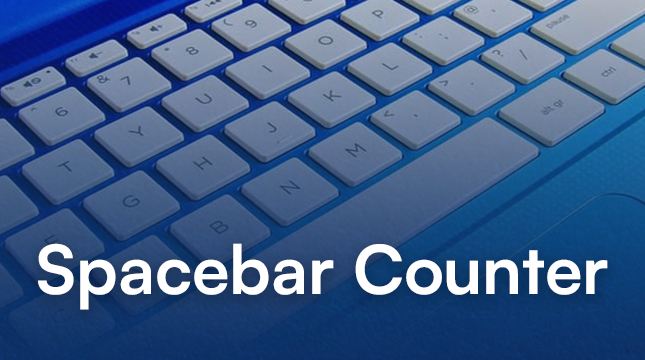This website uses cookies so that we can provide you with the best user experience possible. Cookie information is stored in your browser and performs functions such as recognising you when you return to our website and helping our team to understand which sections of the website you find most interesting and useful.
Spacebar Counter | Netizens Technologies

Have you ever found yourself mindlessly tapping the spacebar while waiting for a webpage to load? Or perhaps you’re a gamer who wants to optimize your jump shot or dodge maneuver in your favorite online game. If so, you’ve stumbled upon the fascinating world of spacebar counters.
This article delves into everything you need to know about spacebar counters, from their basic functionality to their surprising practical applications. We’ll explore how they work, unveil techniques to maximize your clicking speed, and even discover how these simple tools can benefit your gaming prowess, typing skills, and even physical therapy! So, buckle up and get ready to conquer those clicks!
What is a Spacebar Counter?
At its core, a spacebar counter is a web-based tool that tracks the number of times you press the spacebar key within a specific timeframe. Think of it as a virtual stopwatch for your spacebar, measuring your clicking speed and endurance. These online platforms typically offer a minimalist interface – a designated space (often mimicking the actual spacebar key) and a timer. You simply click the virtual spacebar as fast as you can within the allotted time, and the counter displays your clicks per second (CPS).
Benefits of Using a Spacebar Counter:
While seemingly like a simple game, spacebar counters offer a surprising range of benefits. Here are a few:
- Gamification of Practice: They transform practicing your clicking speed into a fun and engaging activity, perfect for anyone who enjoys a friendly challenge.
- Measurable Improvement: The clear click count data allows you to track your progress over time, providing a sense of accomplishment as your clicking speed increases.
- Warm-Up Tool: Gamers can utilize spacebar counters as a quick warm-up exercise before diving into their favorite titles, getting their fingers limber and reflexes sharp.
- Typing Speed and Accuracy Boost: By improving your spacebar speed, you can indirectly enhance your overall typing speed and accuracy since the spacebar is one of the most frequently used keys.
Read More : SERP Analytics Tool
How Does a Spacebar Counter Work?
Understanding the Technology Behind the Clicks:
Spacebar counters are built on a foundation of simple yet effective web programming. When you click the virtual spacebar, JavaScript code embedded in the webpage registers the click and increments a counter variable. This variable is then displayed on the screen, showcasing your real-time CPS. Additionally, a timer function controls the duration of the test, stopping the counter and displaying your final score once the time limit is reached.
Different Types of Spacebar Counters:
There’s no one-size-fits-all approach to spacebar counters. Here’s a breakdown of the most common types:
- Basic Timed Test: This is the classic format, offering a set time limit (usually 5 or 10 seconds) for you to rack up as many clicks as possible.
- Adjustable Time Test: These counters allow you to customize the test duration, letting you tailor the challenge to your specific needs.
- Click-and-Hold Test: This variation requires you to hold down the spacebar for a set duration, measuring your finger endurance.
- Click Accuracy Test: This advanced version incorporates accuracy challenges, requiring you to click specific targets within a time limit, testing both speed and precision.
Mastering the Spacebar: Tips and Techniques
Now that you understand the mechanics, let’s explore ways to conquer the spacebar counter and become a clicking champion!
Choosing the Right Technique:
There are two primary techniques for maximizing your click rate:
- The Single-Finger Frenzy: This involves using a single index finger to rapidly tap the spacebar. Focus on a smooth, rhythmic tapping motion, minimizing finger travel distance.
- The Double-Tap Turbo: This advanced technique utilizes two fingers – one holding down the spacebar halfway, while the other taps rapidly on top of it. This creates a rapid-fire clicking effect, but requires good coordination and practice.
Warming Up for Peak Performance:
Just like any physical activity, warming up your fingers is crucial before attempting a spacebar counter challenge. Simple hand stretches and wrist rolls can improve blood flow and flexibility, preparing your fingers for optimal clicking speed.
Maintaining Consistency and Endurance:
Don’t underestimate the importance of endurance. Clicking at a high speed for extended periods requires stamina. Start with shorter bursts and gradually increase the duration of your clicks as your finger muscles adapt.
Spacebar Counters: Beyond the Fun – Practical Applications
While spacebar counters may seem like a lighthearted way to test your clicking prowess, they offer a surprising range of practical applications:
Boosting Gaming Prowess:
For gamers, spacebar counters are more than just a fun distraction. They can be a valuable training tool to enhance performance in various game genres:
- Platformers: A high clicking speed translates to more precise and rapid jumps, allowing you to navigate complex platforming levels with ease.
- Fighting Games: Fast spacebar tapping can unleash combos and special moves quicker, giving you an edge over your opponents.
- Action RPGs: Dodging enemy attacks and triggering evasive maneuvers often hinge on a quick spacebar press. Spacebar counters can hone your reflexes and reaction time for these crucial moments.
Enhancing Typing Speed and Accuracy:
The spacebar is one of the most frequently used keys while typing. By improving your spacebar speed and accuracy with spacebar counters, you can indirectly boost your overall typing efficiency. As your spacebar clicks become faster and more precise, you’ll naturally find your overall typing speed and accuracy increasing as well.
A Tool for Physical Therapy and Rehabilitation:
Physical therapists are increasingly exploring innovative ways to incorporate technology into rehabilitation programs. Spacebar counters can be surprisingly useful tools for:
- Improving Finger Dexterity: For individuals recovering from hand injuries or experiencing conditions that affect finger mobility, spacebar counters can provide a controlled and measurable way to regain dexterity and coordination.
- Building Finger Strength: Clicking the spacebar repeatedly can help strengthen finger muscles, aiding in tasks that require fine motor control.
- Rehabilitation Games: Some physical therapy software integrates spacebar clicks into interactive games, making rehabilitation exercises more engaging and motivating for patients.
Setting the Space on Fire: Competitive Spacebar Clicking
For those who crave a challenge, the world of competitive spacebar clicking offers a thrilling arena to test your limits.
Exploring Online Leaderboards:
Many spacebar counter websites feature online leaderboards showcasing the top clickers globally or within specific timeframes. This allows you to compare your score with others and strive to climb the ranks.
Training Regimens for Aspiring Champions:
For those aiming for the top of the leaderboards, dedicated training regimens exist. These often involve:
- Structured Practice Sessions: Allocate specific times each day to practice your clicking technique and gradually increase the duration of your attempts.
- Variety of Tests: Don’t limit yourself to just one type of spacebar counter. Experiment with different test formats (timed, click-and-hold, accuracy) to develop well-rounded clicking skills.
- Competitor Analysis: Observe the techniques used by top-ranked clickers on leaderboards. Analyze their clicking patterns and see if you can incorporate elements into your own approach.
The Science Behind Speed: Factors Affecting Click Rate:
Several factors influence your click rate on a spacebar counter:
- Finger Strength and Dexterity: Stronger and more coordinated fingers can generate faster and more consistent clicks.
- Keyboard Quality: The responsiveness and actuation force of your keyboard can significantly impact your clicking speed. Using a mechanical keyboard with low actuation force often allows for faster clicks compared to membrane keyboards.
- Hand and Wrist Position: Maintaining a relaxed but stable hand and wrist position helps minimize fatigue and allows for smoother clicking motions.

Let's Start Your Project
Get free consultation for your digital product idea to turn it into reality!
Get Started





